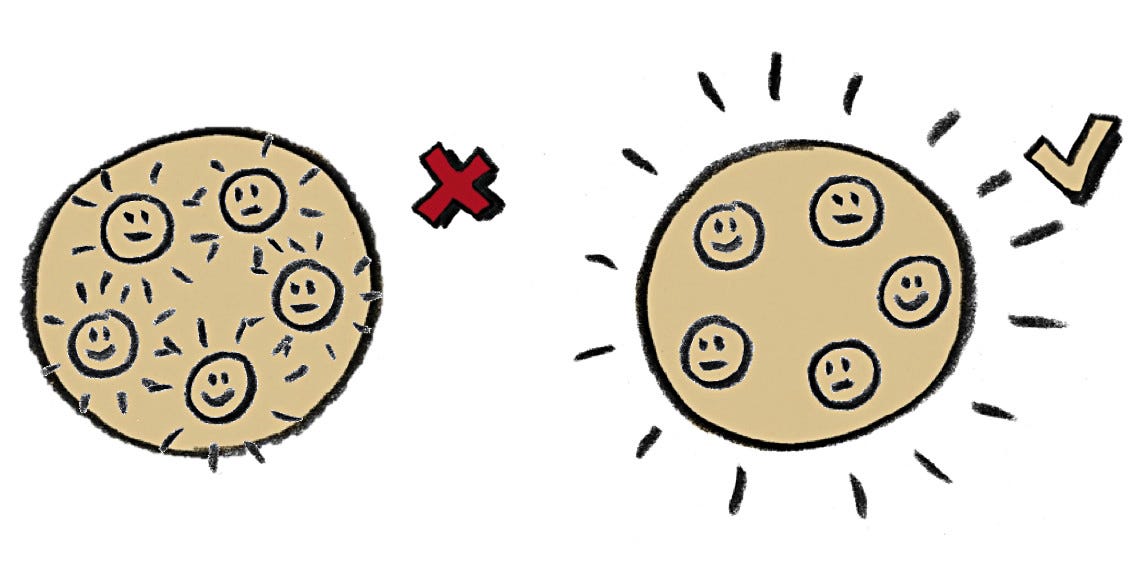Competition inside an organization: Is it good or bad?
Whether internal competition is useful, constructive and appropriate depends on the level on which we let it happen, and wether it is actively stimulated or not
As much as I would like to answer the question with a clear yes or no, I can’t. There is a place in the domain of work and organizations in which competition of a certain kind is good, where it is natural and where it makes sense. In other domains of organizations, however, competition will inevitably turn dysfunctional, toxic, vicious and destructive. Which is why the topic of competition in organizations deserves a closer look.
How to screw up just any company
In most organizations, as some of you are aware, competition on the level of the individual is actively sought, stimulated and incentivized. Such pressure is usually exerted through performance management tools like individual target setting (“OKRs”, "MbO", "quotas", "goals"), individual incentives linked into these targets ("bonuses", "premiums"), and individual performance "appraisal". Often, techniques such as feedback, coaching and skill matrices are also thrown into the mix. We might call this the command-and-control type of competition, which more specifically is a form of steering, of fear-inducing individualization, or top-down-driven rivalry.
All of this is not only dreadful practice: It is also destructive, from an organizational point of view. The fundamental reason why these tools and practices do not actually work is this: Individual performance, in organizations, does not even exist. The notion of individual performance is a crude over-simplification of organizational reality: Performance is not something that individuals within an organization can do, or create by themselves, individually. Instead, performance in organizations always happens in the space between people. It arises from interactions between individuals, or from performing with-each-other-for each-other - which is an expression we discovered at dm-drogerie markt a little more than a decade back.
"In organizations, individual performance does not even exist. Here, performance emerges in the space between people. That is the nature of the organization."
The collective, interdependent nature of work and value creation in companies as well as in not-for-profits is not an option. It is part of organizational physics, or Org Physics. This becomes ever more obvious in complex, dynamic, and globalized markets.
"Given the interdependent nature of value creation, #individuals within an organization cannot actually #compete with each other. They can only be #rivals."
Competition: It is natural in decentralized and self-steering organizations
This insight about the nature of organizational performance leads us to the "good kind" of competition in organizations. It is competition (not: rivalry!) among teams, not individuals: When teams are set up as functionally integrated, highly autonomous, self-organized, self-steering, then they can actually compete for business results. This is a far cry, of course, from the misery that is usually instilled in today´s functionally differentiated command-and-control silos, such as "Sales". But this kind of competition works, as the long-running examples of companies such as Handelsbanken or dm-drogerie-markt have shown.
Healthy competition among self-steering teams capable of running themselves like mini-enterprises, and without the disadvantages of rivalry or centralized steering. depends on a set of principles natural to self-organization.
Firstly, measuring of performance must end at the team level, because the team is the smallest possible unit of performance in an organization.
Secondly, Performance measures on the team level must focus on relative performance (e.g. "Return on Sales as a %, compared to average" or "Cost/Income Ratio, over time"), not fixed in advance (e.g. "Sales of 10.000 units", "Growth of 7%).
Team or team members should of course not be incentivized either.
In fact, we have found in our work on Cell Structure Design and decentralization that healthy competition among business teams in the periphery is easy to proclaim, but that it can only manifest itself if there is also voluntary partnership and active collaboration among those teams. This is key to self-organization and decentralization: Here, competing on team results goes along with partnering on client work and projects, and with solidarity among teams: “We’ll be happy to help you out with this. And at some point we’ll need you to help us out, too!”
Internal competition and solidarity go hand in hand –
or you have neither!
Perhaps the most startling pre-requisite for healthy, constructive and empowering competition among self-steering teams within an organization may at this point be functional integration. We have become so totally used to functional division, or separation of functions into departments, areas, units and silos that most of us think of functional division as "normal". We find it hard to imagine a structure in which groups of, say 4 to 10 people run a small, intra-company business together as a highly autonomous team that would perform most of the various functions of their business themselves, Functions that may be as diverse as marketing, proposing, taking orders, delivering, servicing, billing - with just the occasional service from the organizational center, as needed.
"Functional integration will make your silos, departments, business areas and matrix structures go away. And pave the way for team-based competition that works."
Functional integration not only allows organizations to induce healthy team competition and social density – in the absence of dysfunctional side-effects. It will also always lead to the elimination of functional silos such as Sales, Purchasing or Operations. Or of conventional Business Units. In fact, functional integration always goes hand in hand with complexity-robustness in the shape of federative, decentralized, team-based organizational design. And this is worth achieving these days.
Let the competition begin!






